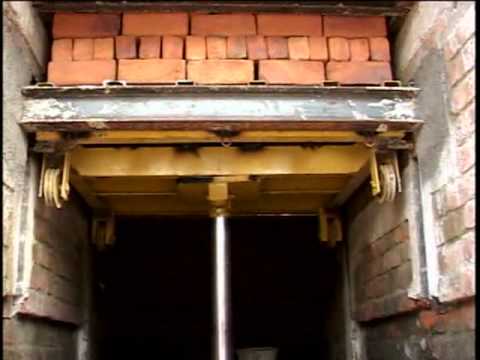Vertical Shaft Brick Kiln
Jump to navigation
Jump to search
About
- updraft kiln for firing bricks
- developed in China in the late 1960s during the cultural revolution
- updraft = heat is reused
- firing shaft is very well insulated on all four sides, minimizing heat loss
- bricks are loaded at the top and removed at ground level in a continuous process (see animation below for details)
- combines low cost of updraft firing with high fuel economy
- operation very similar to that of a vertical shaft lime kiln
- usually fired with low-grade coal fines
- said to be twice as energy efficient as Hoffmann kiln
Videos
vsbk (vertical shaft brick kiln) from sajid on Vimeo.
Related Pages On This Wiki
Pros and Cons vs. Compressed Earth Bricks
Pro:
- no liquid fuel needed (e.g. diesel, ethanol) that would otherwise be required for the CEB press; energy savings due to lower-grade fuel and no need for liquid fuel distillation
- uses low-cost / low-quality fuel such as coal fines or charcoal fines, possibly pyrolysis gas from other processes
- carbon negativity more easily achieved (if part of a Biochar/Brick Co-production System)
- possibility to re-used waste heat (space heating for applications such as greenhouses, fish tanks, etc.)
- no stabilizer needed (e.g. lime, flyash, etc.), leading to energy savings
- reduced wear and tear on the infrastructure per brick (volume is large)
- possibly more stable and more weather-resistant bricks (this requires comparisons, lab testing)
- bricks are of consistently high quality (in fact, they HAVE to be, because of the compressive force that they have to withstand for the stacking)
- possibly less work needed per brick for handling (though this is not clear)
- less need to monitor bricks over weeks (e.g. curing of CEBs)
Con:
- possibly increased fuel use per brick (this is not certain, as the VSBK is very efficient, and the fuel use for CEBs is not zero either)
- a larger installation means less flexibility (this facility is not mobile, in contrast to CEB press)
- potential air pollution problems (this is largely a factor of higher volume/concentration of production)
- requirement for continuous operation (nights/weekends)
Development Proposal
The standard VSBK is coal-fired (low-quality coal fines). As shown in the animation above (on Vimeo), pieces of coal are scattered onto the bricks from the top. If such a brick kiln were re-designed as part of a pyrolysis system and using just the gas Biochar/Brick Co-production System), what would it look like? How could firing the central bricks be assured if gas enters from the sides?
Further Information (links)
- http://www.swisscontact.org/fileadmin/media/Medienberichte/0913_Vertical_Shaft_Brick_Kiln_VSBK_01.pdf (internal copy: here)
- http://www.fastonline.org/CD3WD_40/GATE_DL/BUILDING/VS/EN/VS.HTM
- http://www.teriin.org/technology/brick-kiln-technology
- Devalt.org: "The Vertical Shaft Brick Kiln : a technology for the masses" (internal copy here)
- Article from GATE - 4/91 - Environmental NGOs Humanity Development Library - The Chinese vertical Brick Kiln
